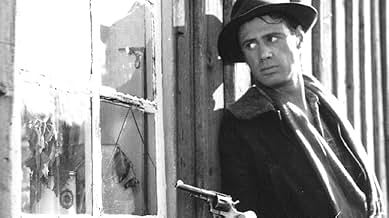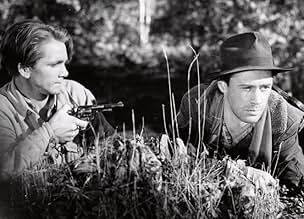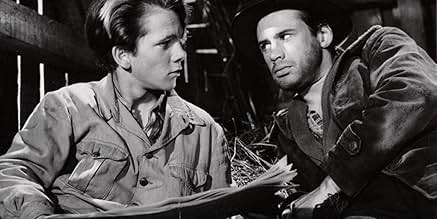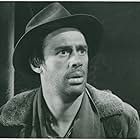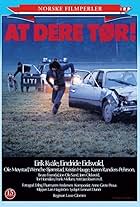Aggiungi una trama nella tua linguaTwo police officers lie dead. Ekstrøm and the youngster Gustav are on their flight. Originally a 1926 story, this film was banned for more than 50 years, due to a high court order banning th... Leggi tuttoTwo police officers lie dead. Ekstrøm and the youngster Gustav are on their flight. Originally a 1926 story, this film was banned for more than 50 years, due to a high court order banning the film for the sake of human privacy.Two police officers lie dead. Ekstrøm and the youngster Gustav are on their flight. Originally a 1926 story, this film was banned for more than 50 years, due to a high court order banning the film for the sake of human privacy.
Trama
Lo sapevi?
- QuizThis movie remained almost unseen for 57 years. It was based on a real double murder in 1926, but when the film was set to premiere in 1950 one of the murderers, having served a full sentence, went to court to have the film stopped. In 1954, the Norwegian Supreme Court banned the film. Since then, only a few people have seen the film. However, as of January 31st, 2007, the film will be available to the public. A legal panel reviewed the film and found that it no longer interferes with any persons right of privacy as all those involved has since passed away. Also, the legal panel noted that had the same case gone to trail today, the outcome would most likely have differed, with freedom of speech outweighing the right to privacy.
- Versioni alternativeThis film was never released in its original version. It turned up five years later - with some footage shelved and some added - as "Savnet siden mandag".
Recensione in evidenza
Two Suspicious Individuals (In orignal Norwegian "Two mistenkelige personer" (meaning "two suspicious persons") was never released in 1950 as it should have been. In stead this film was banned for 47 years in a Norwegian court of law. But finally this special Norwegian gem is released in restored HD.
This movie is a crime drama based upon a real event in Ågård in Ytre Adal on the 22nd of August 1926, when two policemen from Ringerike tried to arrest two bank robbers. They were both killed, and this is about the hunt for the perpetrators, two men, a very young Norwegian and an older Swede.
This film is based upon Norway's first documentary novel by the same name as the movie, by the author Gunnar Larsen, a former journalist in the newspaper Dagbadet, released in 1933.
That was two years after director Tancred Ibsen had debuted with his first movie, the first Norwegian sound feature. Ibsen (grandson of famous writers Henrik Ibsen and Bjørnstjerne Bjørnson, and son of Norwegian Prime Minister Sigurd Ibsen) had been in USA learning the film trade, working on several American films, before returning to Norway.
After making some of Norwegian film's greatest successes, Ibsen already under the movie's production feared trouble, as one of the two killers from 1926 tried to stop the production. The killer feared that this would ruin his chance of a new life after getting out of prison.
The film should have premiered in easter 1950, but an Oslo court and later Norwegian high court ruled that the now-finished movie could not be shown anywhere. This was a hard blow to Tancred Ibsen who knew he had made a great movie, with a huge interest and destined to be a colossal cinema hit.
This resulted in a large financial loss for the production company Norsk Film A/S. The verdict against the film had no parallel in Europe, and this case is quite central to Norwegian court life. The value of privacy was placed higher than the freedom of expression. This later changed dramatically in favor of freedom of expression.
But this also meant most never got to see the movie by one of Norway's most acclaimed movie makers for almost 50 years.
It took 48 years, 20 years after Ibsen's death, to change that ruling, to allow the movie to be shown.
As recently as 1997, Norsk Film AS refused to show the film to the Norwegian Editors' Association out of concern for the descendants of a now-deceased murderer. But in March 1998, the film was released after a decision by the board of Norsk Film AS. Earlier that year, the Norwegian Media Editors' Association held a fictitious trial about the screening of the film. The "judge panel" concisting of Jon Bing, John Stanghelle, and Anne Lise Ryel concluded that the film should be released. This "judgment" had no real importance, but was considered important in principle.
On the 25th of November 1998, the film was shown publicly at Cinemateket in Bergen. But it was not until 2003, 53 years after the ban, that Norsk Filmstudio, which owned the rights to the film, took up the matter again. Two years later Professor Jon Bing considered the ban and it was determined that the film could be made available to the public as the main character in the killings was no longer alive.
In 2007 it was for the first time shown on Norwegian TV. It was also released on DVD in November 2008. In 2024 this movie was made available and released in HD for the first time. Released on interregional (region-free) Blu-Ray Disk by Norwegian Film Classics as the 14th release in a new series with classics, NFK0014, with subtitles in English, and is supposed to be held in stock for film lovers.
The movie is after it's released and has been said to be one of Tancred Ibsen's finest. By some, the film is characterized as a film-noir, though it's a crime story. And certainly, it is a great movie. Well played and beautifully shot on 35 mm in black and white. It's a must-see in your Norwegian filmography.
This movie is a crime drama based upon a real event in Ågård in Ytre Adal on the 22nd of August 1926, when two policemen from Ringerike tried to arrest two bank robbers. They were both killed, and this is about the hunt for the perpetrators, two men, a very young Norwegian and an older Swede.
This film is based upon Norway's first documentary novel by the same name as the movie, by the author Gunnar Larsen, a former journalist in the newspaper Dagbadet, released in 1933.
That was two years after director Tancred Ibsen had debuted with his first movie, the first Norwegian sound feature. Ibsen (grandson of famous writers Henrik Ibsen and Bjørnstjerne Bjørnson, and son of Norwegian Prime Minister Sigurd Ibsen) had been in USA learning the film trade, working on several American films, before returning to Norway.
After making some of Norwegian film's greatest successes, Ibsen already under the movie's production feared trouble, as one of the two killers from 1926 tried to stop the production. The killer feared that this would ruin his chance of a new life after getting out of prison.
The film should have premiered in easter 1950, but an Oslo court and later Norwegian high court ruled that the now-finished movie could not be shown anywhere. This was a hard blow to Tancred Ibsen who knew he had made a great movie, with a huge interest and destined to be a colossal cinema hit.
This resulted in a large financial loss for the production company Norsk Film A/S. The verdict against the film had no parallel in Europe, and this case is quite central to Norwegian court life. The value of privacy was placed higher than the freedom of expression. This later changed dramatically in favor of freedom of expression.
But this also meant most never got to see the movie by one of Norway's most acclaimed movie makers for almost 50 years.
It took 48 years, 20 years after Ibsen's death, to change that ruling, to allow the movie to be shown.
As recently as 1997, Norsk Film AS refused to show the film to the Norwegian Editors' Association out of concern for the descendants of a now-deceased murderer. But in March 1998, the film was released after a decision by the board of Norsk Film AS. Earlier that year, the Norwegian Media Editors' Association held a fictitious trial about the screening of the film. The "judge panel" concisting of Jon Bing, John Stanghelle, and Anne Lise Ryel concluded that the film should be released. This "judgment" had no real importance, but was considered important in principle.
On the 25th of November 1998, the film was shown publicly at Cinemateket in Bergen. But it was not until 2003, 53 years after the ban, that Norsk Filmstudio, which owned the rights to the film, took up the matter again. Two years later Professor Jon Bing considered the ban and it was determined that the film could be made available to the public as the main character in the killings was no longer alive.
In 2007 it was for the first time shown on Norwegian TV. It was also released on DVD in November 2008. In 2024 this movie was made available and released in HD for the first time. Released on interregional (region-free) Blu-Ray Disk by Norwegian Film Classics as the 14th release in a new series with classics, NFK0014, with subtitles in English, and is supposed to be held in stock for film lovers.
The movie is after it's released and has been said to be one of Tancred Ibsen's finest. By some, the film is characterized as a film-noir, though it's a crime story. And certainly, it is a great movie. Well played and beautifully shot on 35 mm in black and white. It's a must-see in your Norwegian filmography.
I più visti
Accedi per valutare e creare un elenco di titoli salvati per ottenere consigli personalizzati
Dettagli
- Paese di origine
- Lingue
- Celebre anche come
- Two Suspicious Individuals
- Azienda produttrice
- Vedi altri crediti dell’azienda su IMDbPro
- Tempo di esecuzione1 ora 32 minuti
- Colore
- Mix di suoni
- Proporzioni
- 1.32:1
- 1.37 : 1
Contribuisci a questa pagina
Suggerisci una modifica o aggiungi i contenuti mancanti

Divario superiore
By what name was To mistenkelige personer (1950) officially released in Canada in English?
Rispondi
